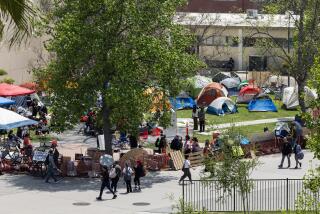Too Valuable for Crops : Farmers in a Dilemma Over Land
The weather along Ventura County’s southern coast is so perfect that “it’s hardly suitable for conversation,” goes an old joke told by local farmers.
The area, known as the Oxnard Plain, holds some of the nation’s most productive farmland, according to agriculture experts. The ocean breezes that cool temperatures in the summer and keep frost away in winter allow farmers there to harvest top-grade produce as many as three times a year from the same piece of ground.
Those same conditions also make the area perfect for new housing, offices and shopping centers. And the potential profits to farmers who sell their land for urban development would make even the most bountiful harvest seem like small potatoes.
But farmlands here do more than produce food. With severe restrictions on development, farmland has become the county’s most powerful planning tool and its first line of defense against the urban sprawl that threatens to push its way north from the San Fernando Valley.
Popular support among the county’s 600,000 residents for prohibiting development of the agricultural greenbelts will likely keep the policy intact, despite worsening economic conditions for farmers and a growing number of complaints from those who say that the county cannot force farmers to work their land.
“People are saying, ‘You go out there and farm until we decide what should be done with your land,’ ” said Rex Laird, executive director of the Ventura County Farm Bureau. “They seem to think that farmers are going to farm no matter what. But farmers aren’t going to pay for the public’s open space if agriculture is no longer economically viable.”
In 1983, the Ventura County Board of Supervisors unanimously passed the Agricultural Lands Protection Program, a county General Plan amendment that prevents approximately 100,000 acres of prime farmland from being developed. Development of the protected farmland is limited to one house for each 40 acres, except for certain land adjacent to cities that has already been designated for future development.
The board said the action was required to preserve agriculture, the county’s leading industry.
At that time, landowners had notified the county of plans to develop about 6,000 acres of prime farmland by 1992. Two years earlier, Jean Harris, a retired Newhall elementary school teacher who moved to Oxnard in 1976 from the San Fernando Valley, had heard about the growing shift of land out of agriculture and became the first person to raise the issue of land preservation.
“I moved out here to breathe and get some space,” said Harris, who helped spearhead the two-year campaign for the plan.
The development restrictions drew support from a coalition of homeowners and environmentalists alarmed by the potential development of farmland in the unincorporated areas that separate the county’s 10 cities. Farmers, although for the most part reluctant to have restrictions placed on their land, organized little serious opposition.
But several consecutive years of falling crop prices have prompted some Ventura County farmers to wonder how long they will be able to continue working their land. Even more discouraging, farmers say, is that only a small number of owners whose land is near cities can sell for development while the rest are likely to find only other farmers as buyers.
Pressure Growing
“The pressure to convert land from agriculture is greater than ever,” said Craig Underwood, 44, a third-generation farmer who grows vegetables, lemons and avocados on about 1,200 acres. “I love the county the way it is. But what happens if I can’t afford to farm anymore? Then what do I do?”
The year-round growing weather of Ventura County had made the area nearly immune to agricultural problems, growers say. But new producers of vegetables in Texas and other parts of California, along with the importation of off-season avocados, citrus and fruits from Mexico, Central America, New Zealand and Chile have pushed down prices and squeezed profits for most of the county’s specialty crops.
The value of the county’s crops fell 5%, or $30 million, last year from the 1984 total of $580 million, according to county reports. The gross income per acre for almost half of the county’s 26 crops has fallen nearly every year since 1979.
And last year, the value of Ventura County vegetables, traditionally one of the area’s strongest crops, fell to its lowest level in four years.
“Celery is selling for $8 a crate, and the break-even cost is about $7 a crate,” said Edgar Terry, 27, who along with his brother are fourth generation Ventura County farmers.
‘Everything Has Been Bad’
Like many county farmers, the Terry family divides its land among four or five different crops and hopes that prices in at least one product will earn a reasonable profit.
“You want to hedge your bets, diversify. If one is bad, then other ones might be better,” Terry said. “But in the last four or five years, everything has been bad.”
Despite the restrictive farm zoning, and the recent planting of citrus and avocado trees in what once had been marginal farmland, the county still is losing about 1,000 acres of agricultural land a year from the approximately 90,000 to 100,000 acres of prime irrigated farmland in the county, said Robert A. Brendler, a county farm adviser with the University of California’s Cooperative Extension in Ventura.
The newest losses of farmland are not from the conversion of active farms to condominiums or houses, but the sale of land that has been left fallow, Brendler said. The appearance for the first time last year of unplanted agricultural land on the fertile Oxnard Plain, Brendler said, indicates a significant shift in the economics of local agriculture there: some farmers have decided that farming is too costly an endeavor for their land.
Limit on Spending
“The value of the land, interest payments and taxes all have to be charged up against the crops,” Brendler said. “Farmers can’t spend more on their land then it is worth.”
A review of county assessor records shows that by 1996, nearly 26,500 acres of Ventura County farmland will come out of protection under the state’s Land Conservation Act, a law that reduces property taxes to landowners in return for their promise to keep the property in agriculture for 10 years. Although most of that land cannot now be developed, some agriculture analysts speculate that those landowners believe that the agricultural preserve restrictions eventually will be eased.
“I think there are a hell of a lot of people in agriculture who were very supportive of the greenbelt ordinances originally and now, after three or four years of low income or losses, they’re desperate to sell and they can’t,” said Ralph Boyd, an agricultural consultant for Coldwell Banker, a real estate firm.
Agricultural land in the Oxnard Plain is priced between $13,000 and $20,000 an acre, while portions of farmland that have been rezoned for housing within the city limits of Oxnard have sold for up to $70,000 an acre, Boyd said.
Boyd said that, in effect, farmers are subsidizing the land as open space for the enjoyment of city dwellers.
‘Cheapest Park’
“Cities view this green panorama as the cheapest park money can buy,” Boyd said.
Out of the county’s prime irrigated farmland, about 17,000 acres lie adjacent to cities, in areas that planners have already earmarked for eventual city annexation and development, according to the Ventura County Farm Bureau. It is those farmers who will be choosing in the next several years between life on the farm and selling to developers.
The eventual conversion of much of the remaining farmland to housing developments is viewed by many as inevitable.
“People need places to live and the best land for farming is also the best land for schools, factories and places for people to live . . ,” Brendler said. “With the demand for land and the big money involved, almost nothing in the way of zoning can have much of an influence.”
More to Read
Start your day right
Sign up for Essential California for news, features and recommendations from the L.A. Times and beyond in your inbox six days a week.
You may occasionally receive promotional content from the Los Angeles Times.






